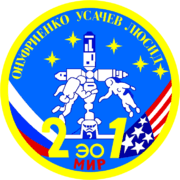Mir EO-21
Mir EO-21 was a long-duration mission aboard the Russian Space station Mir, which occurred between February and September 1996. The crew consisted of two Russian cosmonauts, Commander Yuri Onufrienko and Yury Usachov, as well as American astronaut Shannon Lucid. Lucid arrived at the station about a month into the expedition, and left about a week following its conclusion; NASA refers to her mission as NASA-2.[4] She was the second American to have a long-duration stay aboard Mir, the first being Norman Thagard, as a crew member of Mir EO-18; he stayed on the station for 111 days.[5] Some sources refer to her mission as Mir NASA-1, claiming that she was the first American to have a long-duration stay aboard Mir.[6]
| Mission type | Mir expedition |
|---|---|
| Mission duration | 193.8 days (Onufrienko, Usachyov) (launch to landing) |
| Expedition | |
| Space Station | Mir |
| Began | 21 February 1996 |
| Ended | 2 September 1996 |
| Arrived aboard | Soyuz TM-23 STS-76 (Lucid)[1][2] Space Shuttle Atlantis |
| Departed aboard | Soyuz TM-23 STS-79[1][3] Space Shuttle Atlantis |
| Crew | |
| Crew size | 2 (February-March) 3 (March-September) |
| Members | Yuri Onufrienko Yury Usachov Shannon Lucid* (from March) * - Transferred to EO-22 |
| Callsign | Skif[1] |
 .jpg) Yury Usachov, Yuri Onufrienko, Shannon Lucid Long-term Mir expeditions | |
Crew
| Mir EO-21 | Name | Spaceflight | Launch | Landing | Duration | Notes |
|---|---|---|---|---|---|---|
| Commander | First | 21 February 1996 Soyuz TM-23 |
2 September 1996 Soyuz TM-23 |
193 days | ||
| Flight Engineer | Second | |||||
| Flight Engineer | Fifth and last | 22 March 1996 STS-76 |
26 September 1996 STS-79 |
188 days | Aboard the station for some of Mir EO-22 |
Mission highlights
Crew handover and Mir Cassiopee
On 19 August 1996, the Soyuz TM-24 spacecraft docked with Mir's front port. It brought to the station two of the next long-duration crew, Valery Korzun and Aleksandr Kaleri. The following expedition, Mir EO-22, would be commanded by Korzun. Also aboard Soyuz TM-24 was French astronaut Claudie Haigneré (then called Claudie Andre-Deshays), whose mission is known as Mir Cassiopee.[7][8]
References
- "Mir EO-21". Encyclopedia Astronautica. Archived from the original on 20 November 2010. Retrieved 11 December 2010.
- "STS-76". Encyclopedia Astronautica. Archived from the original on 19 November 2010. Retrieved 11 December 2010.
- "STS-79". Encyclopedia Astronautica. Archived from the original on 29 November 2010. Retrieved 11 December 2010.
- "NASA-2". NASA.
- Marsha Freeman (July 2000). Challenges of human space exploration. Springer. p. 260. ISBN 1-85233-201-8.
- "Mir NASA-1". Encyclopedia Astronautica. Archived from the original on 2010-11-29.
- "Mir Cassiopee". Encyclopedia Astronautica. Archived from the original on 2011-10-11.
- "International cooperation in space manned programs realization". Yuri Gagarin Cosmonauts Training Center. Archived from the original on 16 June 2011. Retrieved 11 December 2010.